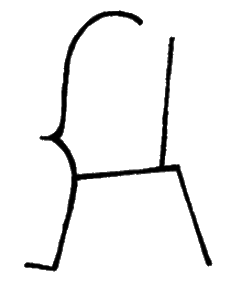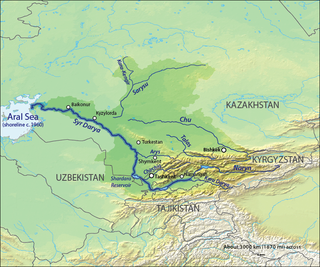Related Research Articles

The Wusun were an ancient semi-nomadic steppe people mentioned in Chinese records from the 2nd century BC to the 5th century AD.

The Yuezhi (Chinese: 月氏; pinyin: Yuèzhī, Ròuzhī or Rùzhī; Wade–Giles: Yüeh4-chih1, Jou4-chih1 or Ju4-chih1;) were an ancient people first described in Chinese histories as nomadic pastoralists living in an arid grassland area in the western part of the modern Chinese province of Gansu, during the 1st millennium BC. After a major defeat at the hands of the Xiongnu in 176 BC, the Yuezhi split into two groups migrating in different directions: the Greater Yuezhi (Dà Yuèzhī 大月氏) and Lesser Yuezhi (Xiǎo Yuèzhī 小月氏). This started a complex domino effect that radiated in all directions and, in the process, set the course of history for much of Asia for centuries to come.

Zhang Qian was a Chinese diplomat, explorer, and politician who served as an imperial envoy to the world outside of China in the late 2nd century BC during the Western Han dynasty. He was one of the first official diplomats to bring back valuable information about Central Asia, including the Greco-Bactrian remains of the Macedonian Empire as well as the Parthian Empire, to the Han dynasty imperial court, then ruled by Emperor Wu of Han.

The Ashina were a Turkic tribe and the ruling dynasty of the Göktürks. This clan rose to prominence in the mid-6th century when the leader, Bumin Qaghan, revolted against the Rouran Khaganate. The two main branches of the family, one descended from Bumin and the other from his brother Istämi, ruled over the eastern and western parts of the Göktürk confederation, respectively, forming the First Turkic Khaganate (552–603).
Barsils ~ Barsilts, were an Oghur Turkic semi-nomadic Eurasian tribe. Barsils might be identified with Bagrasik. Barsils are included in the list of steppe people living north of Derbend in the Late Antique Syrian compilation of Zacharias Rhetor, and are also mentioned in documents from the second half of the 6th century in connection with the westward migration of the Eurasian Avars. When the Avars arrived, according to Theophylact Simocatta, "the Barsilt (Barsilians), Onogurs, and Sabirs were struck with horror (...) and honoured the newcomers with brilliant gifts."
The Dingling were an ancient people who appear in Chinese historiography in the context of the 1st century BCE.
Esegels were an Oghur Turkic dynastic tribe in the Middle Ages who joined and would be assimilated into the Volga Bulgars.
Modu was the son of Touman and the founder of the empire of the Xiongnu. He came to power by ordering his men to kill his father in 209 BCE.

Kangju was the Chinese name of a kingdom in Central Asia during the first half of the first millennium CE. The name Kangju is now generally regarded as a variant or mutated form of the name Sogdiana. According to contemporaneous Chinese sources, Kangju was the second most powerful state in Transoxiana, after the Yuezhi. Its people, known in Chinese as the Kāng (康), were evidently of Indo-European origins, spoke an Eastern Iranian language, and had a semi-nomadic way of life. The Sogdians may have been the same people as those of Kangju and closely related to the Sakas, or other Iranian groups such as the Asii.

Utigurs were Turkic nomadic equestrians who flourished in the Pontic–Caspian steppe in the 6th century AD. They possibly were closely related to the Kutrigurs and Bulgars.

The Toquz Oghuz was a political alliance of nine Turkic Tiele tribes in Inner Asia, during the early Middle Ages. The Toquz Oghuz was consolidated and subordinated within the First Turkic Khaganate (552–603) and remained as a nine-tribe alliance after the Khaganate fragmented.

Yueban, colloquially: "Weak Xiongnu", was the name used by Chinese historians for remnants of the Northern Xiongnu in Zhetysu, now part of modern-day Kazakhstan. In Chinese literature they are commonly called Yueban. The Yuebans gained their own visibility after disintegration of the Northern Xiongnu state, because unlike the main body of the Northern Xiongnu, who escaped from the Chinese sphere of knowledge, the Yueban tribes remained closer to China.
Yabghu, also rendered as Jabgu, Djabgu or Yabgu, was a state office in the early Turkic states, roughly equivalent to viceroy. The title carried autonomy in different degrees, and its links with the central authority of Khagan varied from economical and political subordination to superficial political deference. The title had also been borne by Turkic princes in the upper Oxus region in post-Hephthalite times.

Nushibi was a Chinese collective name for five tribes of the right (western) wing in the Western Turkic Khaganate, and members of "ten arrows" confederation found in the Chinese literature. The references to Nushibi appeared in Chinese sources in 651 and disappeared after 766. The Nushibi tribes occupied the lands of the Western Turkic Khaganate west of the Ili River of contemporary Kazakhstan.
The Kumo Xi, also known as the Tatabi, were ancient steppe people located in current Northeast China from 207 CE to 907 CE. After the death of their ancestor Tadun in 207, they were no longer called Wuhuan but joined the Khitan Xianbei in submitting to the Yuwen Xianbei. Their history is widely linked to the more famous Khitan.

The Tiele, also named Gaoche or Gaoju, were a tribal confederation of Turkic ethnic origins living to the north of China proper and in Central Asia, emerging after the disintegration of the confederacy of the Xiongnu. Chinese sources associate them with the earlier Dingling.
The history of the Uyghur people extends over more than two millennia and can be divided into four distinct phases: Pre-Imperial, Imperial, Idiqut, and Mongol, with perhaps a fifth modern phase running from the death of the Silk Road in AD 1600 until the present.

Duolu was a tribal confederation in the Western Turkic Khaganate. The Turgesh Khaganate (699-766) may have been founded by Duolu remnants.

The Kyrgyz Khaganate was a Turkic empire that existed for about a century between the early 6th and 13th centuries. It ruled over the Yenisei Kyrgyz people, who had been located in southern Siberia since the 6th century. By the 9th century, the Kyrgyz had asserted dominance over the Uyghurs who had previously ruled the Kyrgyz. The empire was established as a khaganate from 539 to 1218, lasting 679 years. The khaganate's territory at its height would briefly include parts of modern-day China, Kazakhstan, Kyrgyzstan, Mongolia, and Russia. After the 10th century, there was little information on the Yenisei Kyrgyz. It is believed the khaganate had survived in its traditional homeland until 1207.

This is a short History of the central steppe, an area roughly equivalent to modern Kazakhstan. Because the history is complex it is mainly an outline and index to the more detailed articles given in the links. It is a companion to History of the western steppe and History of the eastern steppe and is parallel to the History of Kazakhstan and the History of Central Asia.
References
- 1 2 3 Yu. Zuev, "Early Türks: Sketches of history and ideology", p. 56
- ↑ Jiu Tangshu Vol. 199 lower txt. "鐵勒,本匈奴別種。自突厥強盛,鐵勒諸郡分散,衆漸寡弱。至武德初,有薛延陀、契苾、回紇、都播、骨利幹、多覽葛、僕骨、拔野古、同羅、渾部、思結、斛薛、奚結、阿跌、白霫等,散在磧北。" tr. "Tiele are originally Xiongnu's splinter stock. As Tujue are strong and prosperous, all Tiele districts are divided and scattered, the masses gradually dwindled and weakened. At the beginning of Wude [era], there are Xueyantuo, Qibi, Huihe, Dubo, Guligan, Duolange, Pugu, Bayegu, Tongluo, Hun, Sijie, Huxue, Xijie, Adie, Baixi, etc. scattered north of the desert."
- ↑ Blažek, V. & Schwartz, M. "Tocharians: Who they were, where they came from, and where they lived" in Tocharian Studies: Works 1 (2011), p. 119
- ↑ G. Haloun, "Zur Üe-tsï-Frage. In: Zeitschrift der Deutschen Morgenländischen Gesellschaft", 91, NF 16, 1937, p. 301, in Yury Zuev, "Early Türks: Sketches of history and ideology", p. 42
- 1 2 3 4 Benjamin, Craig (October 2003). "The Yuezhi Migration and Sogdia". Transoxiana Webfestschrift. 1 (Ēran ud Anērān). Transoxiana. Retrieved 29 May 2015.
- ↑ Beckwith 2009 , pp. 380–383
- ↑ Enoki, Koshelenko & Haidary 1994 , pp. 171–191
- 1 2 3 Beckwith 2009 , pp. 6–7
- ↑ François & Hulsewé 1979 , p. 215
- ↑ Shiji 《史記·大宛列傳》 Original text: 匈奴攻殺其父,而昆莫生棄於野。烏嗛肉蜚其上,狼往乳之。
- ↑ Beckwith 2009 , p. 6
- ↑ Watson 1993 , pp. 237–238
- ↑ Beckwith 2009 , p. 2
- ↑ Sinor & Klyashtorny 1996 , pp. 328–329
- ↑ Hanshu 《漢書·張騫李廣利傳》 Original text 時,月氏已為匈奴所破,西擊塞王。
- ↑ Yu. Zuev, "Early Türks: Sketches of history and ideology", p. 55
- ↑ Tang Huiyao Vol. 72 txt. "奚結馬。與磧南突厥馬相類。在雞服山南。赫連枝川北住。今雞祿州。印坎" tr. "The Xijie's horses and the horses of the Tujue south of the shoal. They dwelt south of Jifu mountains, north of Helianzhi river, now [in] Jilu pronvince. Their tamga [resembles] [the character] 坎"
- ↑ Wang Pu, "Summary review of Tang dynasty, 618-907 (Tang Huiyao)", Shanghai, 1958, ch. 72, p. 1307, in Yu. Zuev, "Early Türks: Sketches of history and ideology", p. 45
- ↑ Mogoin Shine Usu monument, line 14
- ↑ Yu. Zuev, "Early Türks: Sketches of history and ideology", p. 45
- ↑ J. Bacot, "Reconnaissance en haute asie septentrionale par cinq envoyé ouigours au VIIIE siècle.", JA, 2, 1956, p. 147, in Yu. Zuev, "Early Türks: Sketches of history and ideology", p. 45
- ↑ Barthold, W. 12 Vorlesungen über die Geschichte der Türken Mittelasiens, Berlin, Arthur Collignon, Deutsche Gesellschaft für Islamkunde, 1935, p. 37
- ↑ Yu. Zuev, "Early Türks: Sketches of history and ideology", p. 57
Sources
- Beckwith, Christopher I. (16 March 2009). Empires of the Silk Road: A History of Central Eurasia from the Bronze Age to the Present. Princeton University Press. ISBN 978-1-4008-2994-1 . Retrieved 30 December 2014.